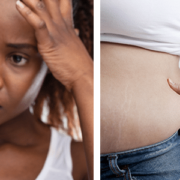LipoDissolve Fat Loss: Spot Reduce Fat (Without Diet or Exercise)
Fat often accumulates in stubborn “pockets” on the belly, butt, hips, or thighs in areas that just don’t respond to exercise or diet. Wouldn’t it be great if you could “spot reduce” those trouble spots – rapidly losing fat or inches in a specific, targeted area?
While every personal trainer will tell you that there is no way to “spot reduce” with diet and exercise, you CAN “spot reduce” … with revolutionary new LipoDissolve fat loss injections available at Ruthie Harper, MD in Austin, TX!
“Spot Reducing” Fat Loss with LipoDissolve
LipoDissolve is a cosmetic treatment available at Ruthie Harper, MD in Austin, TX that uses injections to dissolve and eliminate fat in targeted areas of the body. The procedure is non-surgical and minimally invasive, making it an appealing option for those who want to remove stubborn fat without undergoing more invasive procedures like liposuction.
In this article, renowned Austin, TX weight loss doctor Ruthie Harper, MD discusses what LipoDissolve is, how it works, what areas of the body can be treated, how much fat can be removed, what recovery is like, and how long results last.
What is LipoDissolve?
LipoDissolve, also known as injection lipolysis, is a cosmetic treatment that involves injecting a solution into the targeted area of the body to break down and remove unwanted fat cells. The injected solution contains a combination of phosphatidylcholine (PC) and deoxycholate (DC), which are naturally occurring substances found in the body that are involved in the breakdown and removal of fat.
The solution used in LipoDissolve injections breaks down the cell membrane of the targeted fat cells, causing them to rupture and release their contents. The released fat is then metabolized by the body and excreted as waste. The solution also causes some inflammation in the treated area, which triggers the body’s healing processes that helps to tighten the skin, as well as reduce the appearance of cellulite.
The LipoDissolve Fat Removal Procedure
Before LipoDissolve fat removal, the targeted area is numbed with a local anesthetic. The solution is then injected into the area using a small needle. The number of injections and the amount of solution used depends on the size of the area being treated and the amount of fat to be removed.
LipoDissolve fat removal typically takes less than an hour in our Austin, TX office. Patients can return to their normal activities immediately after. Some patients may experience mild swelling, redness, or bruising in the treated area, but these side effects usually subside within a few days.
Areas of the Body that LipoDissolve can Treat
LipoDissolve can be used to target fat in almost any area of the body, including the abdomen, thighs, hips, buttocks, arms, back, and chin. It is especially effective for “spot reducing” smaller, stubborn pockets of fat that are resistant to diet and exercise.
The amount of fat that can be removed with LipoDissolve depends on several factors, including the size of the area being treated, the amount of fat present, and the patient’s overall health. On average, patients can expect to lose up to 8 ounces (about a cup!) of fat in a single treatment. Multiple sessions may be required to achieve the desired results.
LipoDissolve Fat Removal Recovery
Unlike liposuction surgery, recovery after LipoDissolve is typically quick and easy. Patients may experience some mild swelling, redness, or bruising in the treated area, but these side effects usually subside within a few days. Patients are typically able to return to their normal activities immediately after the procedure.
It is recommended that patients avoid strenuous exercise and alcohol for at least 24 hours after the procedure. Other than that, you can return to work or picking up the kids after school! Patients should also avoid exposing the treated area to sunlight or tanning beds for at least a week after the procedure.
LipoDissolve Fat Removal Results
The results of LipoDissolve can be long-lasting with proper maintenance, because LipoDissolve breaks down and removes the unwanted fat cells from the body.
While the treated fat cells are permanently removed from the body, new fat cells can still develop in the treated area if the patient does not maintain a healthy lifestyle. This means that if the patient gains weight after the procedure, new weight gained in the treated area can cause the results to diminish. So, it is important for patients to maintain a healthy diet and exercise routine to ensure long-lasting results.
Many times, LipoDissolve is the perfect kick-start to maintaining better habits. Renowned Austin, TX weight loss doctor Ruthie Harper, MD can help patients maintain healthy lifestyle! Other patients may already be maintaining a healthy life style and simply need a little help “spot reducing” trouble spots of fat. Some patients may also require additional sessions of LipoDissolve to maintain their results.
Patients can expect to see noticeable fat loss results within 4-6 weeks after the procedure, while the body naturally eliminates the ruptured fat cells. Final fat loss results may take up to 3-6 months to fully develop.
LipoDissolve vs Liposuction
While LipoDissolve and liposuction are both popular cosmetic procedures for fat reduction, LipoDissolve is a non-surgical, minimally invasive procedure that involves no incisions, no painful recovery, and no downtime.
LipoDissolve is performed under local anesthetic, while liposuction requires general anesthesia and liposuction patients may need to take a week or more off from work. LipoDissolve also carries almost no risk of complications while liposuction carries the risk of infection, bleeding, nerve damage, and scarring.
LipoDissolve also costs a fraction of the price of liposuction – which can be $5,000 to $10,000 or more!
LipoDissolve Fat Removal | Austin, TX
While LipoDissolve is not a substitute for a healthy lifestyle, it can be ideal for patients who want to “spot reduce” trouble areas that are not responding to diet or exercise.
If you would like to slim down troubled spots of unwanted fat – without exercise, dieting, or downtime – schedule a LipoDissolve consultation at our Austin, TX office today.




